wiring CHEVROLET ASTRO 2003 Owners Manual
[x] Cancel search | Manufacturer: CHEVROLET, Model Year: 2003, Model line: ASTRO, Model: CHEVROLET ASTRO 2003Pages: 386, PDF Size: 17.31 MB
Page 93 of 386
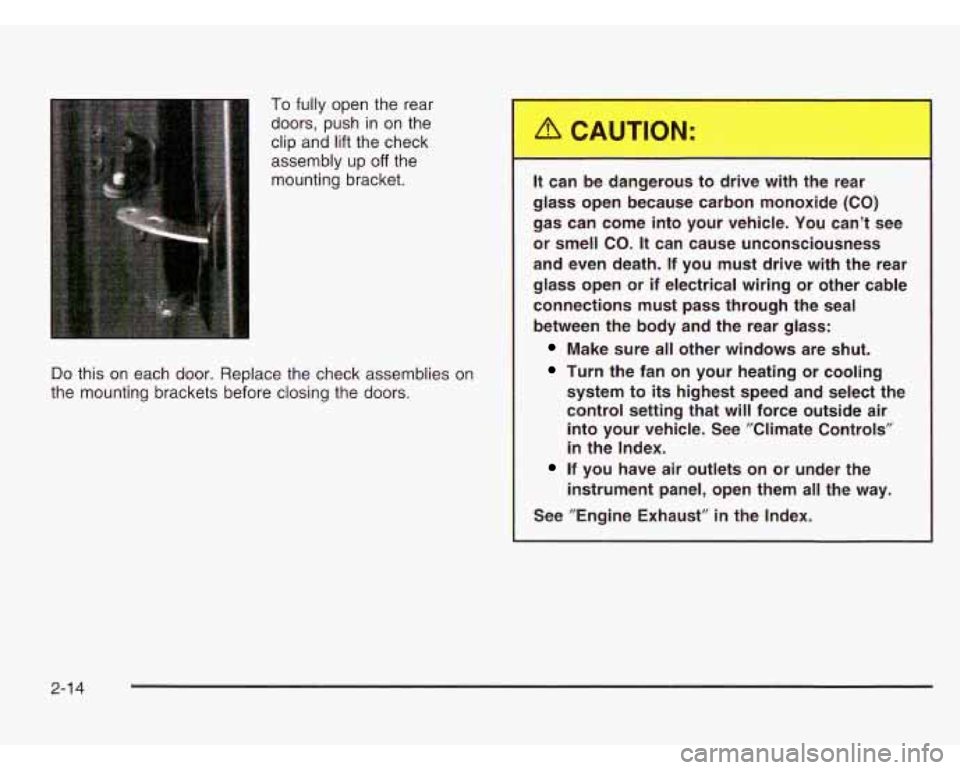
To fully open the rear
doors, push in on the
clip and
lift the check
assembly up
off the
mounting bracket.
Do this on each door. Replace the check assemblies on
the mounting brackets before closing the doors.
It can be dangerous to drive with the rear
glass open because carbon monoxide (CO)
gas can come into your vehicle. You can’t see
or smell CO.
It can cause unconsciousness
and even death. If you must drive with the rear
glass open or if electrical wiring or other cable
connections must pass through the seal between the body and the rear glass:
Make sure all other windows are shut.
Turn the fan on your heating or cooling
system to its highest speed and select the control setting that will force outside air into your vehicle. See ”Climate Controls”
in the Index.
instrument panel, open them
all the way.
If you have air outlets on or under the
See ”Engine Exhaust”
in the Index.
2-1 4
Page 132 of 386
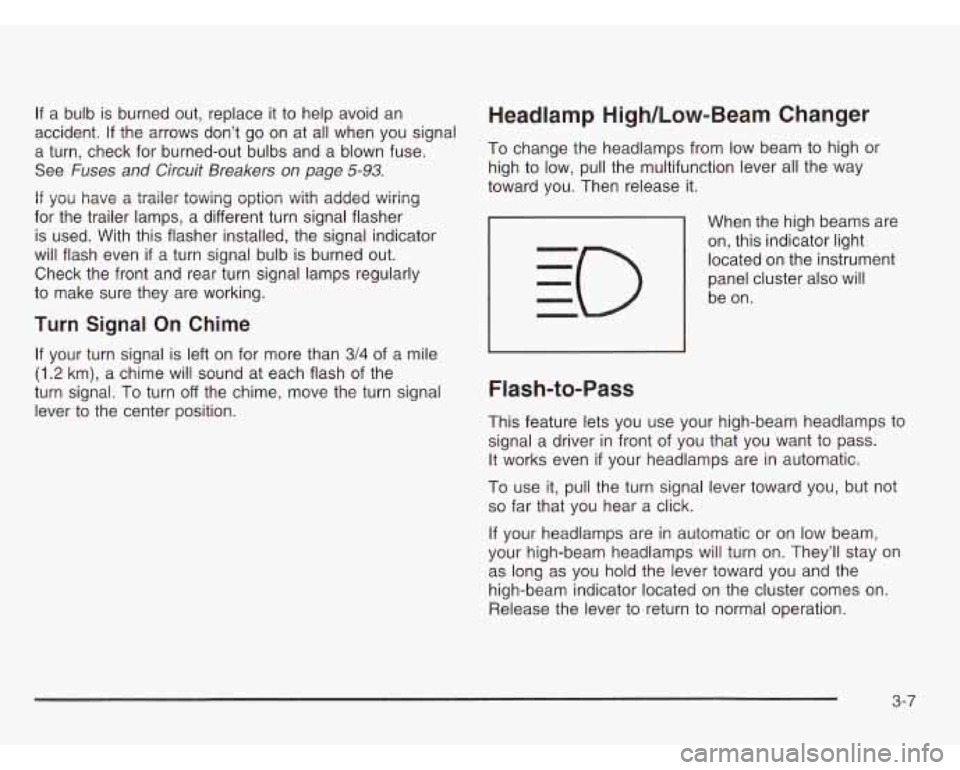
If a bulb is burned out, replace it to help avoid an
accident.
If the arrows don’t go on at all when you signal
a turn, check for burned-out bulbs and a blown fuse.
See
Fuses and Circuit Breakers on page 5-93.
If you have a trailer towing option with added wiring
for the trailer lamps, a different turn signal flasher
is used. With this flasher installed, the signal indicator
will flash even
if a turn signal bulb is burned out.
Check the front and rear turn signal lamps regularly
to make sure they are working.
Turn Signal On Chime
If your turn signal is left on for more than 3/4 of a mile
(1.2 km), a chime will sound at each flash of the
turn signal. To turn
off the chime, move the turn signal
lever to the center position.
Headlamp High/Low-Beam Changer
To change the headlamps from low beam to high or
high to low, pull the multifunction lever all the way
toward you. Then release it.
When the high beams are
on, this indicator light located on the instrument
panel cluster also will
be on.
Flash-to-Pass
This feature lets you use your high-beam headlamps to
signal a driver in front of you that you want to pass.
It works even
if your headlamps are in automatic.
To use it, pull the turn signal lever toward you, but not
so far that you hear a click.
If your headlamps are in automatic or on low beam,
your high-beam headlamps will turn on. They’ll stay
on
as long as you hold the lever toward you and the
high-beam indicator located on the cluster comes on.
Release the lever to return to normal operation.
3-7
Page 151 of 386
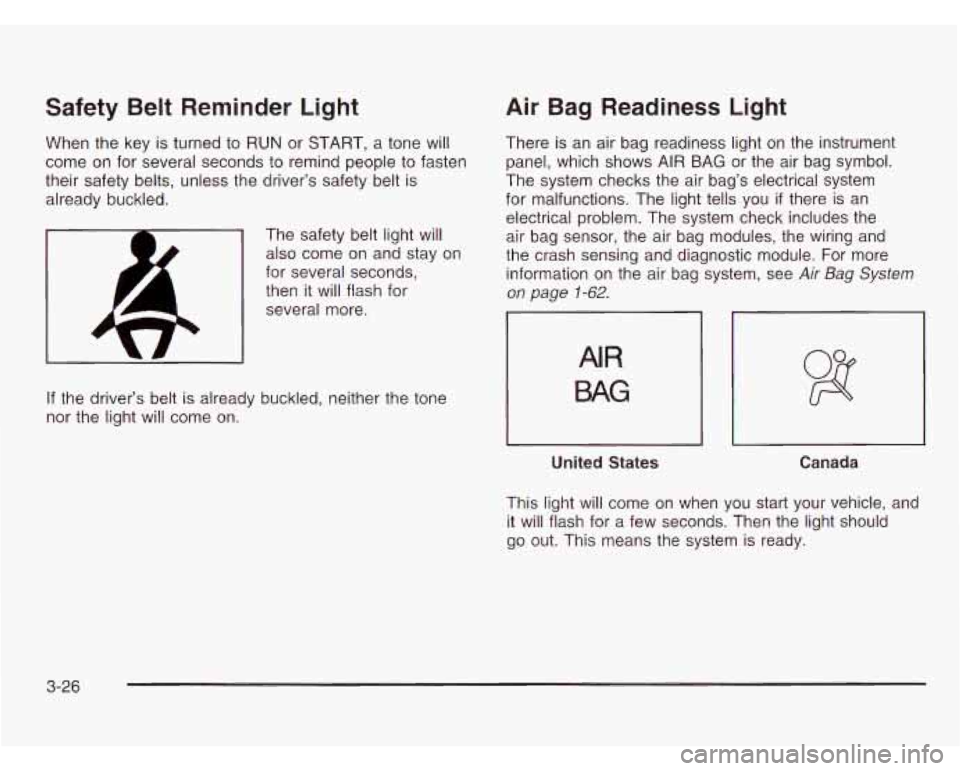
Safety Belt Reminder Light
When the key is turned to RUN or START, a tone will
come on for several seconds to remind people to fasten
their safety belts, unless the driver’s safety belt is
already buckled.
The safety belt light will
also come on and stay on
for several seconds,
then it will flash for
several more.
If the driver’s belt is already buckled, neither the tone
nor the light will come
on.
Air Bag Readiness Light
There is an air bag readiness light on the instrument
panel, which shows AIR BAG or the air bag symbol.
The system checks the air bag’s electrical system
for malfunctions. The light tells you
if there is an
electrical problem. The system check includes the
air bag sensor, the air bag modules, the wiring and
the crash sensing and diagnostic module. For more
information on the air bag system, see
Air Bag System
on page 1-62.
AIR
BAG
United States Canada
This light will
come on when you start your vehicle, and
it will flash for a few seconds. Then the light should
go out. This means the system is ready.
3-26
Page 213 of 386
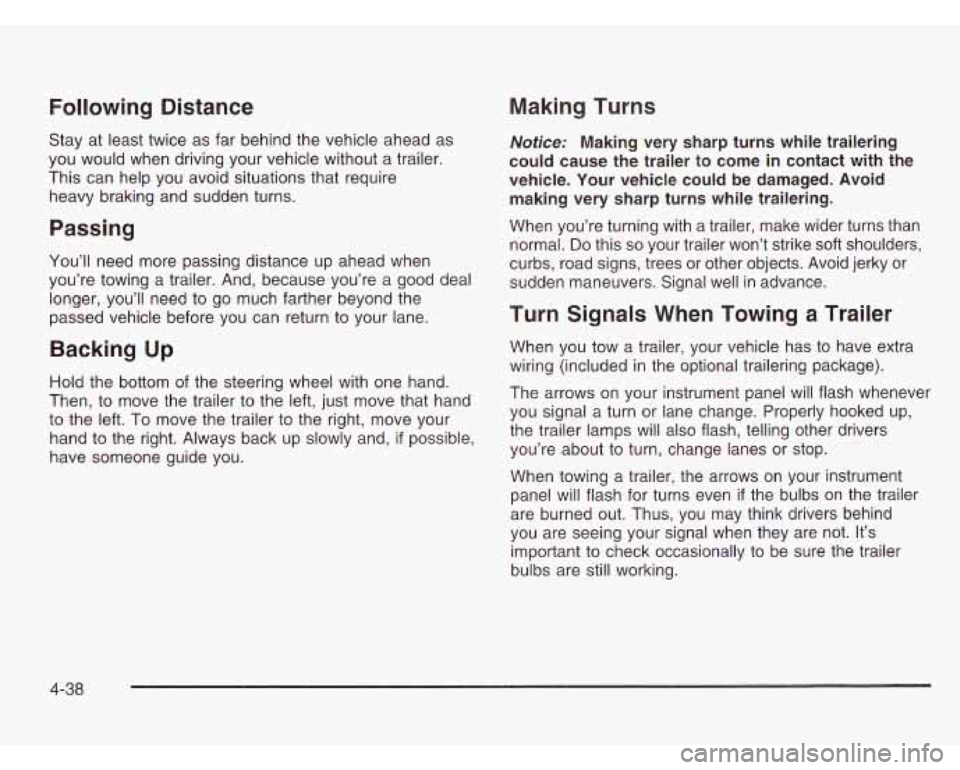
Following Distance
Stay at least twice as far behind the vehicle ahead as
you would when driving your vehicle without a trailer.
This can help you avoid situations that require
heavy braking and sudden turns.
Passing
You’ll need more passing distance up ahead when
you’re towing a trailer. And, because you’re a good deal
longer, you’ll need to go much farther beyond the
passed vehicle before you can return to your lane.
Backing Up
Hold the bottom of the steering wheel with one hand.
Then, to move the trailer to the left, just move that hand
to the left.
To move the trailer to the right, move your
hand to the right. Always back up slowly and,
if possible,
have someone guide you.
Making Turns
Notice: Making very sharp turns while trailering
could cause the trailer to come in contact with the
vehicle. Your vehicle could be damaged. Avoid
making very sharp turns while trailering.
When you’re turning with a trailer, make wider turns than
normal.
Do this so your trailer won’t strike soft shoulders,
curbs, road signs, trees or other objects. Avoid jerky or
sudden maneuvers. Signal well in advance.
Turn Signals When Towing a Trailer
When you tow a trailer, your vehicle has to have extra
wiring (included in the optional trailering package).
The arrows on your instrument panel will flash whenever
you signal a turn or lane change. Properly hooked up,
the trailer lamps will also flash, telling other drivers
you’re about to turn, change lanes or stop.
When towing a trailer, the arrows on your instrument
panel will flash for turns even
if the bulbs on the trailer
are burned out. Thus, you may think drivers behind
you are seeing your signal when they are not. It’s
important to check occasionally to be sure the trailer
bulbs are still working.
4-38
Page 216 of 386
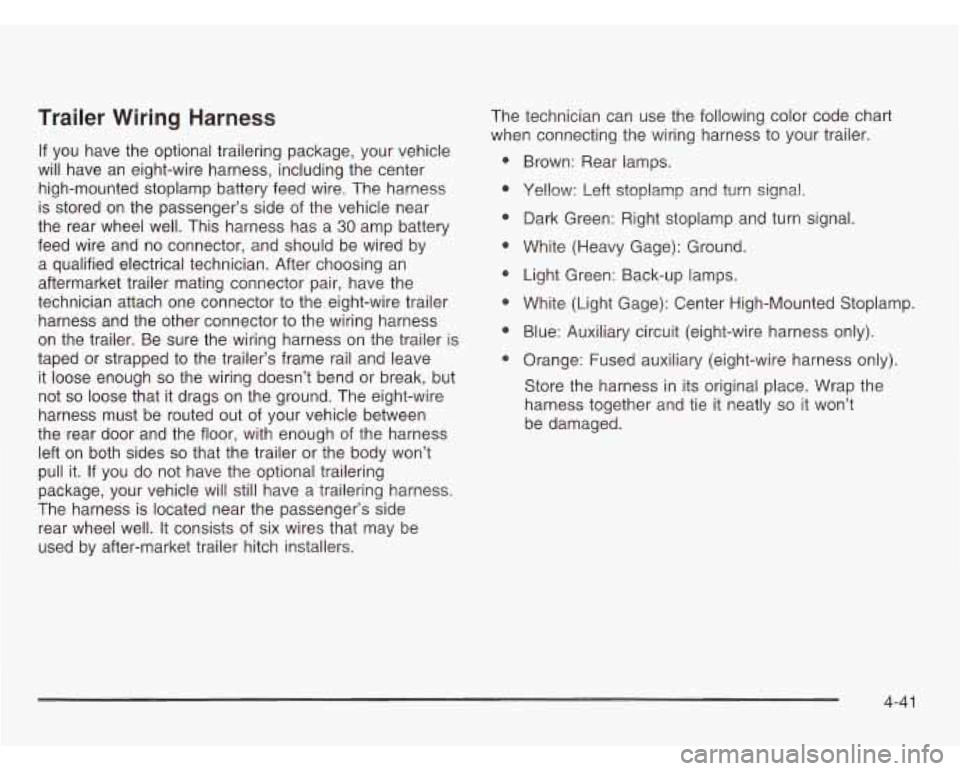
Trailer Wiring Harness
If you have the optional trailering package, your vehicle
will have an eight-wire harness, including the center
high-mounted stoplamp battery feed wire. The harness
is stored on the passenger’s side of the vehicle near
the rear wheel well. This harness has a
30 amp battery
feed wire and no connector, and should be wired by
a qualified electrical technician. After choosing an
aftermarket trailer mating connector pair, have the
technician attach one connector to the eight-wire trailer
harness and the other connector to the wiring harness
on the trailer. Be sure the wiring harness on the trailer
is
taped or strapped to the trailer’s frame rail and leave
it loose enough
so the wiring doesn’t bend or break, but
not
so loose that it drags on the ground. The eight-wire
harness must be routed out of your vehicle between
the rear door and the floor, with enough of the harness
left on both sides
so that the trailer or the body won’t
pull it. If you do not have the optional trailering
package, your vehicle will still have a trailering harness.
The harness is located near the passenger’s side
rear wheel well. It consists
of six wires that may be
used by after-market trailer hitch installers. The
technician can use the following color code chart
when connecting the wiring harness to your trailer.
e
e
Brown: Rear lamps.
Yellow: Left stoplamp and turn signal.
Dark Green: Right stoplamp and turn signal.
White (Heavy Gage): Ground.
Light Green: Back-up lamps.
White (Light Gage): Center High-Mounted Stoplamp.
Blue: Auxiliary circuit (eight-wire harness only).
Orange: Fused auxiliary (eight-wire harness only).
Store the harness in its original place. Wrap the
harness together and tie it neatly
so it won’t
be damaged.
4-4 1
Page 219 of 386
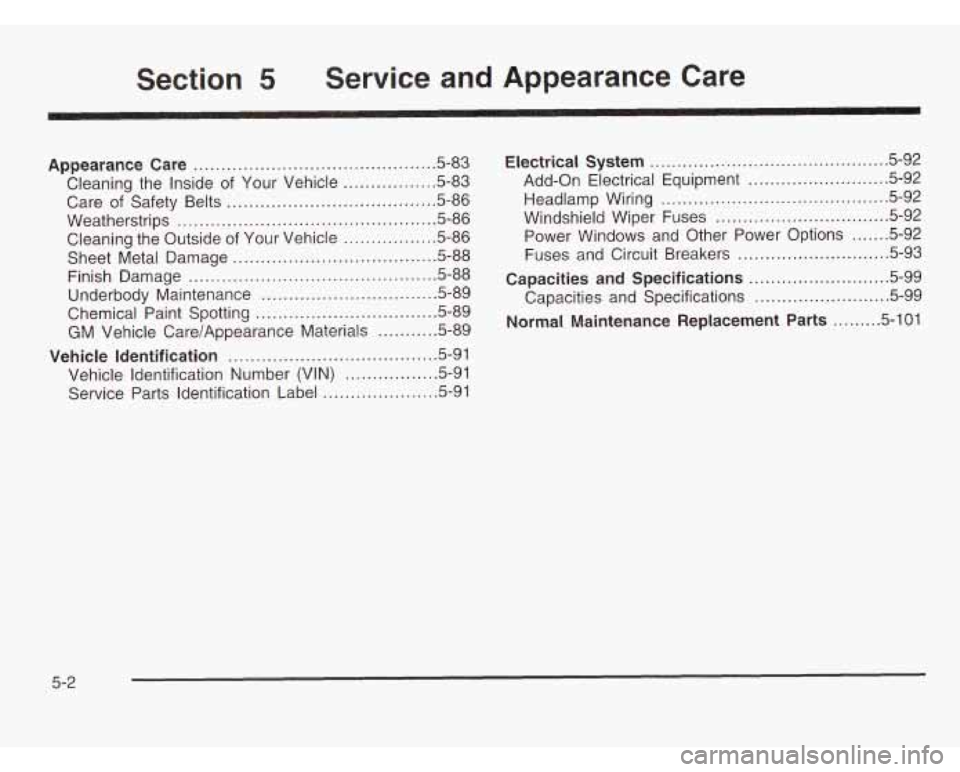
Section 5 Service and Appearance Care
Appearance Care ............................................ 5.83
Care
of Safety Belts ...................................... 5-86
Weatherstrips
............................................... 5-86
Sheet Metal Damage
..................................... 5-88
Finish Damage
............................................. 5-88
Underbody Maintenance
................................ 5-89
Chemical Paint Spotting
................................. 5-89
GM Vehicle Care/Appearance Materials ........... 5-89
Vehicle Identification ...................................... 5-91
Vehicle Identification Number (VIN)
................. 5-91
Service Parts Identification Label
..................... 5-91
Cleaning the Inside of Your Vehicle ................. 5-83
Cleaning the Outside
of Your Vehicle ................. 5-86
Electrical System ............................................ 5.92
Add-on Electrical Equipment
......................... 5-92
Headlamp Wiring
.......................................... 5-92
Windshield Wiper Fuses
................................ 5-92
Power Windows and Other Power Options
....... 5-92
Fuses and Circuit Breakers
............................ 5-93
Capacities and Specifications ......................... 3-99
Capacities and Specifications
......................... 5-99
Normal Maintenance Replacement Parts ......... 5-101
5-2
Page 309 of 386
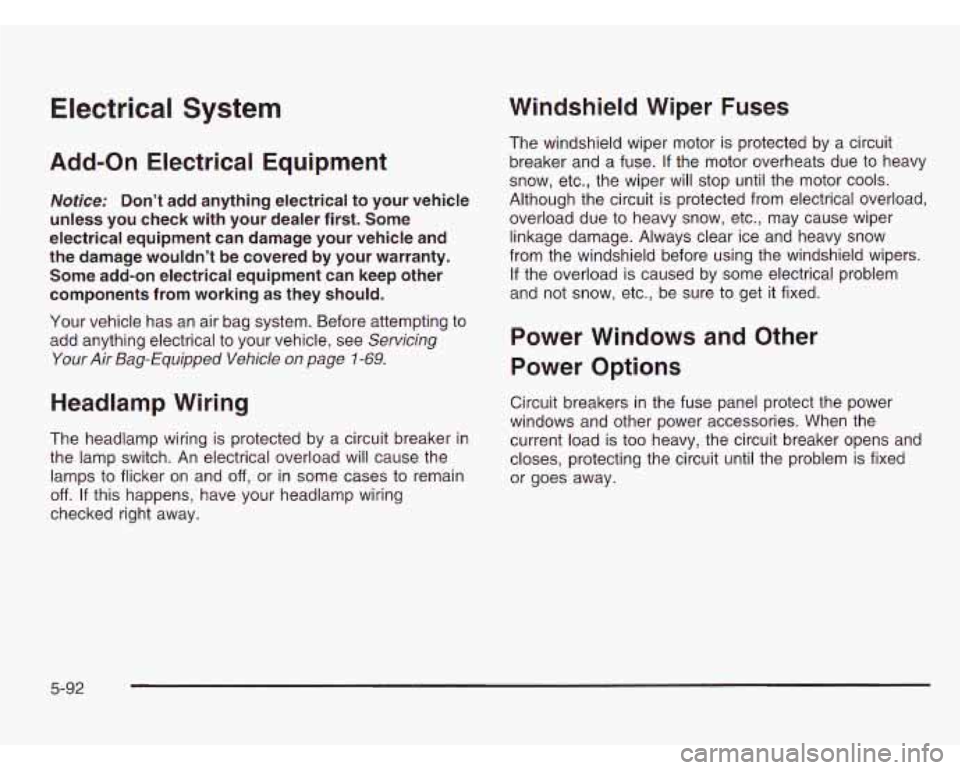
Electrical System
Add-on Electrical Equipment
Notice: Don’t add anything electrical to your vehicle
unless you check with your dealer first. Some
electrical equipment can damage your vehicle and
the damage wouldn’t be covered by your warranty.
Some add-on electrical equipment can keep other
components from working
as they should.
Your vehicle has an air bag system. Before attempting to
add anything electrical to your vehicle, see
Servicing
Your Air Bag-Equipped Vehicle on page
1-69.
Headlamp Wiring
The headlamp wiring is protected by a circuit breaker in
the lamp switch. An electrical overload will cause the
lamps to flicker on and
off, or in some cases to remain
off. If this happens, have your headlamp wiring
checked right away.
Windshield Wiper Fuses
The windshield wiper motor is protected by a circuit
breaker and a fuse.
If the motor overheats due to heavy
snow, etc., the wiper will stop until the motor cools.
Although the circuit is protected from electrical overload,
overload due to heavy snow, etc., may cause wiper
linkage damage. Always clear ice and heavy snow
from the windshield before using the windshield wipers.
If the overload
is caused by some electrical problem
and not snow, etc., be sure to get it fixed.
Power Windows and Other
Power Options
Circuit breakers in the fuse panel protect the power
windows and other power accessories. When the
current load is too heavy, the circuit breaker opens and
closes, protecting the circuit until the problem is fixed
or goes away.
5-92
Page 310 of 386
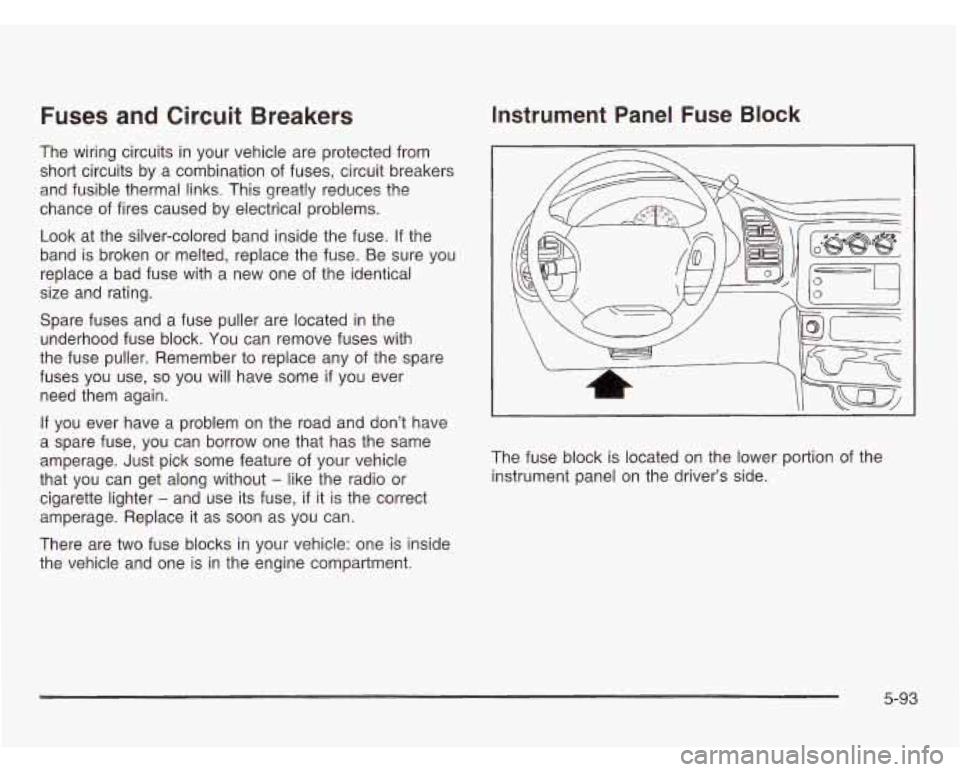
Fuses and Circuit Breakers
The wiring circuits in your vehicle are protected from
short circuits by a combination of fuses, circuit breakers
and fusible thermal links. This greatly reduces the
chance of fires caused by electrical problems.
Look at the silver-colored band inside the fuse.
If the
band is broken or melted, replace the fuse. Be sure you
replace a bad fuse with a new one of the identical
size and rating.
Spare fuses and a fuse puller are located in the
underhood fuse block. You can remove fuses with
the fuse puller. Remember to replace any of the spare
fuses you use,
so you will have some if you ever
need them again.
If you ever have a problem on the road and don’t have
a spare fuse, you can borrow one that has the same
amperage. Just pick some feature of your vehicle
that you can get along without
- like the radio or
cigarette lighter
- and use its fuse, if it is the correct
amperage. Replace it as soon as you can.
There are two fuse blocks in your vehicle: one
is inside
the vehicle and one is in the engine compartment.
Instrument Panel Fuse Block
The fuse block is located on the lower portion of the
instrument panel on the driver’s side.
5-93
Page 314 of 386
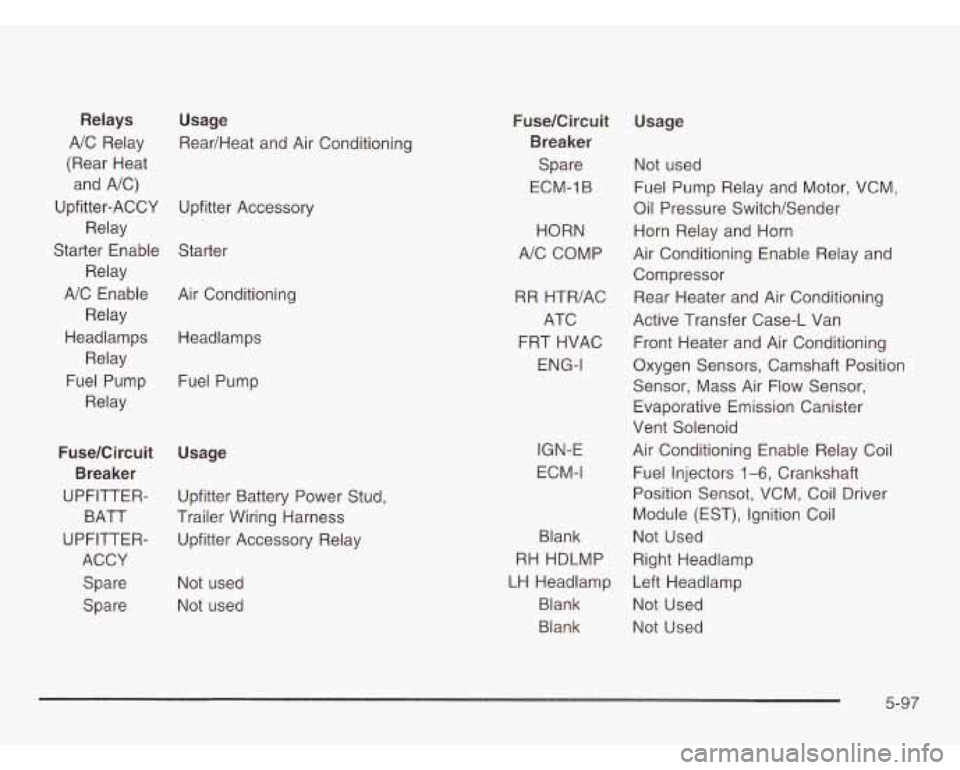
Usage
Rear/Heat and Air Conditioning
Relays
AIC Relay
(Rear Heat
and AIC)
Relay
Relay
A/C Enable
Relay
Upfitter-ACCY
Upfitter Accessory
Starter Enable Starter
Headlamps Relay
Fuel Pump
Relay Air
Conditioning
Headlamps
Fuel Pump
FuselCircuit
Usage
UPFITTER- Upfitter Battery Power Stud,
BATT Trailer Wiring Harness
UPFITTER- Upfitter Accessory Relay
ACCY
Spare Not used
Spare Not used
Breaker FuselCircuit
Breaker
Spare
ECM-1 B
HORN
AIC COMP
RR HTR/AC ATC
FRT HVAC
ENG-I
IGN-E
ECM-I
Blank
RH HDLMP
LH Headlamp
Blank
Blank
Usage
Not used
Fuel Pump Relay and Motor, VCM,
Oil Pressure Switch/Sender
Horn Relay and Horn
Air Conditioning Enable Relay and
Compressor
Rear Heater and Air Conditioning
Active Transfer Case-L Van
Front Heater and Air Conditioning
Oxygen Sensors, Camshaft Position
Sensor, Mass Air Flow Sensor,
Evaporative Emission Canister
Vent Solenoid
Air Conditioning Enable Relay Coil
Fuel Injectors
1-6, Crankshaft
Position Sensot, VCM, Coil Driver
Module (EST), Ignition Coil
Not Used
Right Headlamp
Left Headlamp
Not Used
Not Used
5-97
Page 371 of 386
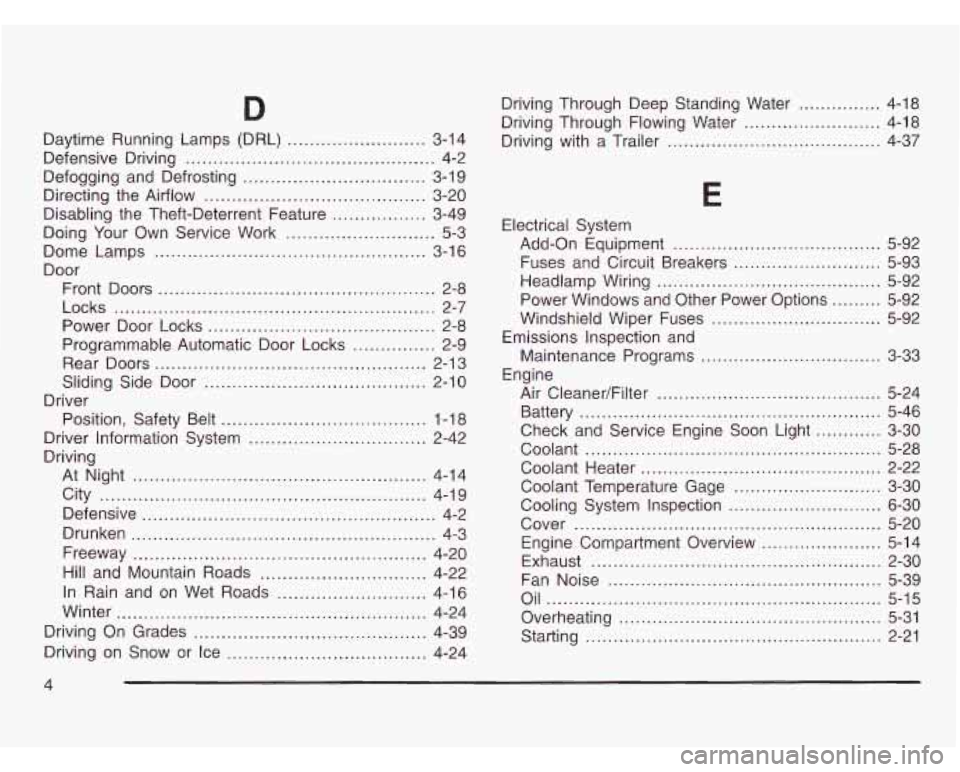
Daytime Running Lamps (DRL) ...................... 3-14
Defensive Driving
............................................. 4-2
Defogging and Defrosting
................................. 3-1 9
Directing the Airflow
........................................ 3-20
Disabling the Theft-Deterrent Feature
................. 3-49
Doing Your Own Service Work
........................... 5-3
Dome Lamps
.......................................... ~ ~~~ 3-16
Door Front Doors
............................................... 2-8
Locks
.......................................................... 2-7
Power Door Locks
......................................... 2-8
Programmable Automatic Door Locks
............... 2-9
Rear Doors
................................................. 2-13
Sliding Side Door
........................................ 2-10
Position, Safety Belt
..................................... 1-1 8
Driver Information System
................................ 2-42
At Night
..................................................... 4-14
City
........................................................... 4-19
Defensive
..................................................... 4-2
Drunken
....................................................... 4-3
Freeway
..................................................... 4-20
Hill and Mountain Roads
.............................. 4-22
In Rain and on Wet Roads ........................... 4-16
Winter
........................................................ 4-24
Driving On Grades
.......................................... 4-39
Driving on Snow or Ice
.................................... 4-24
Driver
Driving Driving
Through Deep Standing Water
............... 4-18
Driving Through Flowing Water
......................... 4-18
Driving with a Trailer
....................................... 4-37
E
Electrical System
Add-on Equipment
...................................... 5-92
Headlamp Wiring
......................................... 5-92
Fuses and
Circuit Breakers
........................... 5-93
Power Windows and Other Power Options
......... 5-92
Windshield Wiper Fuses
............................... 5-92
Emissions Inspection and
Engine Maintenance Programs
................................. 3-33
Air Cleaner/Filter
......................................... 5-24
Battery
....................................................... 5-46
Check and Service Engine Soon Light
............ 3-30
Coolant
...................................................... 5-28
Coolant Heater
............................................ 2-22
Coolant Temperature Gage
........................... 3-30
Cooling System Inspection
............................ 6-30
Cover
........................................................ 5-20
Engine Compartment Overview
...................... 5-14
Exhaust
..................................................... 2-30
Fan Noise
.................................................. 5-39
Oil
............................................................. 5-15
Starting
...................................................... 2-21
Overheating
................................................ 5-31
4